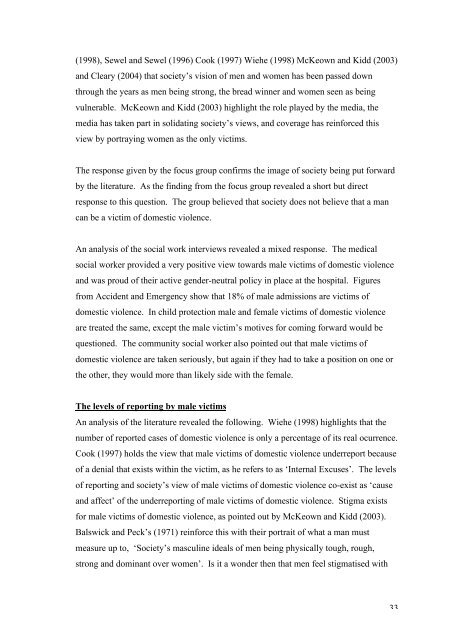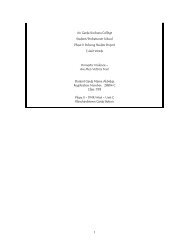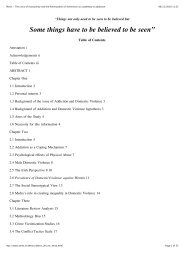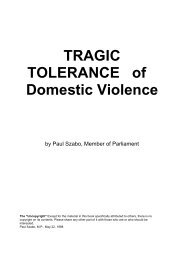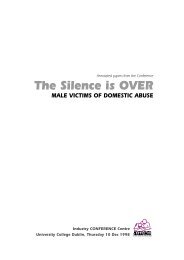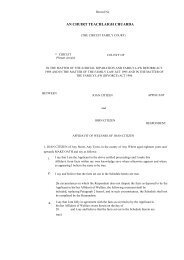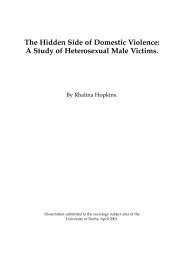MALE VICTIMS OF DOMESTIC VIOLENCE Informing Social ... - Amen
MALE VICTIMS OF DOMESTIC VIOLENCE Informing Social ... - Amen
MALE VICTIMS OF DOMESTIC VIOLENCE Informing Social ... - Amen
Create successful ePaper yourself
Turn your PDF publications into a flip-book with our unique Google optimized e-Paper software.
(1998), Sewel and Sewel (1996) Cook (1997) Wiehe (1998) McKeown and Kidd (2003)<br />
and Cleary (2004) that society’s vision of men and women has been passed down<br />
through the years as men being strong, the bread winner and women seen as being<br />
vulnerable. McKeown and Kidd (2003) highlight the role played by the media, the<br />
media has taken part in solidating society’s views, and coverage has reinforced this<br />
view by portraying women as the only victims.<br />
The response given by the focus group confirms the image of society being put forward<br />
by the literature. As the finding from the focus group revealed a short but direct<br />
response to this question. The group believed that society does not believe that a man<br />
can be a victim of domestic violence.<br />
An analysis of the social work interviews revealed a mixed response. The medical<br />
social worker provided a very positive view towards male victims of domestic violence<br />
and was proud of their active gender-neutral policy in place at the hospital. Figures<br />
from Accident and Emergency show that 18% of male admissions are victims of<br />
domestic violence. In child protection male and female victims of domestic violence<br />
are treated the same, except the male victim’s motives for coming forward would be<br />
questioned. The community social worker also pointed out that male victims of<br />
domestic violence are taken seriously, but again if they had to take a position on one or<br />
the other, they would more than likely side with the female.<br />
The levels of reporting by male victims<br />
An analysis of the literature revealed the following. Wiehe (1998) highlights that the<br />
number of reported cases of domestic violence is only a percentage of its real ocurrence.<br />
Cook (1997) holds the view that male victims of domestic violence underreport because<br />
of a denial that exists within the victim, as he refers to as ‘Internal Excuses’. The levels<br />
of reporting and society’s view of male victims of domestic violence co-exist as ‘cause<br />
and affect’ of the underreporting of male victims of domestic violence. Stigma exists<br />
for male victims of domestic violence, as pointed out by McKeown and Kidd (2003).<br />
Balswick and Peck’s (1971) reinforce this with their portrait of what a man must<br />
measure up to, ‘Society’s masculine ideals of men being physically tough, rough,<br />
strong and dominant over women’. Is it a wonder then that men feel stigmatised with<br />
33


